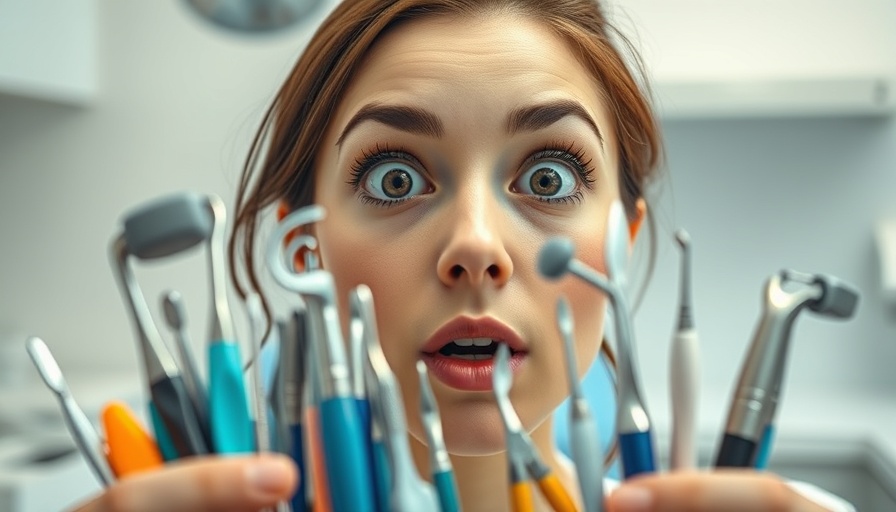
Understanding Dental Tools: Unlocking the Secrets of Stay-Healthy Teeth
When it comes to dental hygiene, many people underestimate the importance of the tools used by professionals. In her enlightening video, dental hygienist Whitney shares insights about the various dental instruments utilized during routine cleaning appointments. Understanding these tools not only enhances one’s appreciation of oral care but also fosters a sense of empowerment in maintaining oral health.
In 'Dental Tools Used During a Teeth Cleaning - EXPLAINED!', the discussion dives into the specific dental instruments used by hygienists, exploring key insights that sparked deeper analysis on our end.
The Essential Instruments: Probes and Explorers
The journey into dental hygiene starts with two critical instruments: the probe and the Explorer. The probe functions as a periodontal measuring tool, akin to a small ruler that assesses the gap between gums and teeth. Numbers ranging from 1 to 3 indicate healthy gum tissue, while higher numbers reveal potential issues like inflammation or even periodontal disease. Discovering the condition of your gums is paramount, as it determines whether a basic cleaning or deep cleaning is warranted.
On the other end of this tool often lies the Explorer, an indispensable companion used during dental exams. Its unique hook-like structure allows hygienists to inspect teeth for any sticky spots that might suggest decay or tartar buildup, both critical indicators of dental health. Whitney introduces the 11-12 Explorer, especially known for its effectiveness in detecting tartar, a mineral build-up that can lead to more severe complications if left untreated.
Scalers and Curettes: The Heavyweights of Dental Cleaning
Moving beyond the initial assessment, dental hygienists employ scalers and curettes crucial for cleaning. Scalers are designed to scrape away tartar, uniquely shaped to adapt to either anterior or posterior teeth. The specific shape of each scaler optimizes its effectiveness depending on the tooth surface it addresses, ensuring thorough cleaning without causing harm.
Curettes, generally less pointed than scalers, are also employed depending on the thickness of tartar and the desired approach. Unique Gracie curettes even cater to specific areas of the mouth, making it easier to reach difficult spots. The decision to choose scalers versus curettes often hinges on the hygienist’s expertise and the specific needs of the patient, highlighting the personal touch that characterizes many dental practices.
Embracing Technology: The Ultrasonic Scaler Revolution
With advancements in dental technology, ultrasonic scalers have emerged as game-changers in the cleaning process. Utilizing high-frequency vibrations and pressurized water, these tools significantly reduce the effort and time needed for effective cleaning. They prove especially beneficial in cases with heavy tartar buildup, delivering a more thorough and efficient cleaning while ensuring patient comfort.
Whitney describes her practice of adjusting the power settings of the ultrasonic scaler depending on the patient’s needs, illustrating a personalized approach that many dental hygienists adopt. The advent of such advanced tools might prompt a revolution in optimal dental care practices, driving a shift towards more routine use of ultrasonic technology in dental clinics.
The Importance of Routine Polishing
After the rigorous cleaning process, the finishing touch often comes in the form of polishing. Utilizing a flavorful abrasive paste or air polishers, dental hygienists provide that satisfying smooth finish to your teeth. This step not only contributes to oral hygiene but also elevates the patient’s overall experience—something essential for encouraging regular dental visits.
Conclusion: Empowering Yourself with Dental Knowledge
Understanding the various dental instruments used during a cleaning, from probes to ultrasonic scalers, empowers patients to engage more actively in their oral health journeys. Whitney's video serves as a valuable resource, illuminating the intricate processes undertaken during a dental visit while enhancing awareness due to the significance of these tools. For those interested in pursuing a future in dental hygiene, Whitney also provides resources such as a free RDH video checklist—an invaluable asset for aspiring professionals.
By familiarizing yourself with the tools and techniques used in dental hygiene, you not only gain insight into your own healthcare but also cultivate a proactive attitude towards maintaining your smile.
 Add Row
Add Row  Add
Add 




Write A Comment